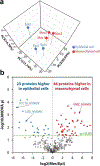New mass spectrometry technologies contributing towards comprehensive and high throughput omics analyses of single cells
- PMID: 30507980
- PMCID: PMC6349538
- DOI: 10.1039/c8an01574k
New mass spectrometry technologies contributing towards comprehensive and high throughput omics analyses of single cells
Abstract
Mass-spectrometry based omics technologies - namely proteomics, metabolomics and lipidomics - have enabled the molecular level systems biology investigation of organisms in unprecedented detail. There has been increasing interest for gaining a thorough, functional understanding of the biological consequences associated with cellular heterogeneity in a wide variety of research areas such as developmental biology, precision medicine, cancer research and microbiome science. Recent advances in mass spectrometry (MS) instrumentation and sample handling strategies are quickly making comprehensive omics analyses of single cells feasible, but key breakthroughs are still required to push through remaining bottlenecks. In this review, we discuss the challenges faced by single cell MS-based omics analyses and highlight recent technological advances that collectively can contribute to comprehensive and high throughput omics analyses in single cells. We provide a vision of the potential of integrating pioneering technologies such as Structures for Lossless Ion Manipulations (SLIM) for improved sensitivity and resolution, novel peptide identification tactics and standards free metabolomics approaches for future applications in single cell analysis.
Figures








References
-
- Dagogo-Jack I and Shaw AT, Nature Reviews Clinical Oncology, 2018, 15, 81. - PubMed
-
- Braun S, Vogl FD, Naume B, Janni W, Osborne MP, Coombes RC, Schlimok G, Diel IJ, Gerber B and Gebauer G, New England journal of medicine, 2005, 353, 793–802. - PubMed
-
- Braun S, Kentenich C, Janni W, Hepp F, de Waal J, Willgeroth F, Sommer H and Pantel K, Journal of clinical oncology, 2000, 18, 80-80. - PubMed
Publication types
MeSH terms
Grants and funding
LinkOut - more resources
Full Text Sources
Research Materials

